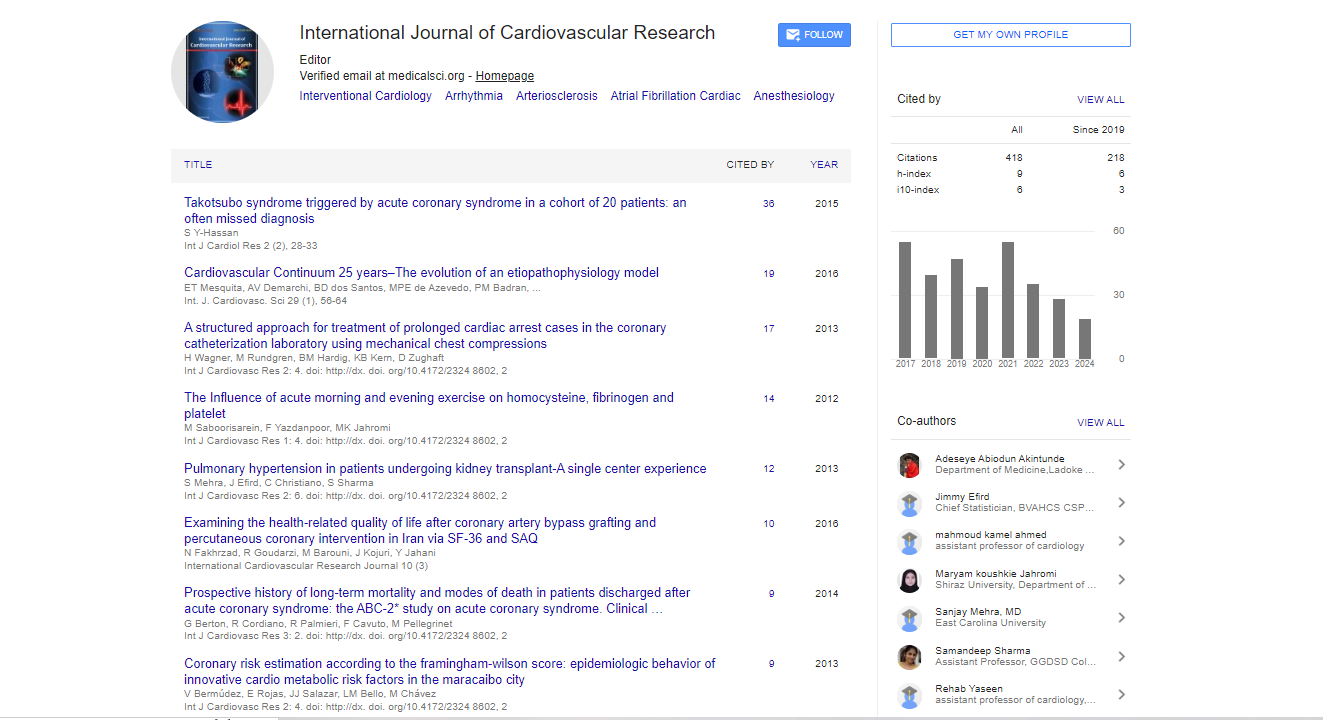Opinion Article, Int J Cardiol Res Vol: 13 Issue: 4
Cardiac Rehabilitation and Lifestyle Interventions: A Comprehensive Approach to Cardiovascular Health
Michael Lee*
1Department of Cardiology, UCSF School of Medicine, California, United States of America
*Corresponding Author: Michael Lee,
Department of Cardiology, UCSF School of
Medicine, California, United States of America
E-mail: michael.lee@ucsf.edu
Received date: 15 July, 2024 Manuscript No. ICRJ-24-149283;
Editor assigned date: 17 July, 2024, PreQC No. ICRJ-24-149283 (PQ);
Reviewed date: 31 July, 2024, QC No. ICRJ-24-149283;
Revised date: 07 August, 2024, Manuscript No. ICRJ-24-149283 (R);
Published date: 14 August, 2024, DOI: 10.4172/2324-8602.1000573
Citation: Lee M (2024) Cardiac Rehabilitation and Lifestyle Interventions: A Comprehensive Approach to Cardiovascular Health. Int J Cardiol Res 13:4.
Description
Cardiovascular Diseases (CVDs) are the leading cause of morbidity and mortality worldwide. Among the most effective interventions to improve outcomes in patients with cardiovascular conditions is Cardiac Rehabilitation (CR). CR is a multidisciplinary, evidence based program designed to improve cardiovascular health through lifestyle changes, physical activity, psychological support and medical optimization. Cardiac Rehabilitation (CR) is a comprehensive program designed for individuals recovering from cardiovascular events such as myocardial infarction, Coronary Artery Bypass Grafting (CABG), heart failure and angioplasty. The primary goal of CR is to restore optimal physical, psychological and social well-being while preventing future cardiovascular incidents. According to the American Heart Association (AHA) and the European Society of Cardiology (ESC), CR programs significantly reduce mortality, recurrent cardiovascular events and hospital readmissions by emphasizing the importance of long term health behaviors.
Each CR program begins with a comprehensive medical evaluation to assess cardiovascular risk, establish personalized goals and guide the selection of appropriate interventions. Physicians determine the patient’s baseline condition, which includes measuring cholesterol levels, blood pressure, glucose levels and other biomarkers of cardiovascular health. Supervised exercise programs are central to CR, improving cardiovascular function, enhancing physical capacity and reducing overall morbidity and mortality. Exercise is usually prescribed based on the patient’s physical abilities and cardiovascular risk factors. Programs often include aerobic exercise (walking, cycling and swimming) and resistance training. According to studies, regular exercise reduces the risk of cardiovascular mortality by 25%-30%. Nutrition plays a pivotal role in cardiovascular health. CR includes dietary counseling to help patients adopt heart-healthy eating habits. The Mediterranean diet, which emphasizes fruits, vegetables, whole grains, lean protein and healthy fats is often recommended for reducing cholesterol levels and improving overall cardiovascular function. Sodium restriction and moderation of alcohol intake are also advised to help control blood pressure.
Cardiovascular events are often associated with psychological distress, including depression, anxiety and Post-Traumatic Stress Disorder (PTSD). Psychosocial support is an integral component of CR, aiming to reduce these mental health burdens. Psychologists or counselors may work with patients on stress management techniques, Cognitive Behavioral Therapy (CBT) and coping mechanisms. Smoking is one of the most significant risk factors for CVDs. As part of CR, patients are provided with resources and support to quit smoking. Smoking cessation dramatically reduces the risk of recurrent cardiovascular events and improves overall survival rates. CR includes the optimization of medical therapy, such as medications for managing blood pressure, lipid levels and diabetes. Patients are also educated on the importance of adherence to these therapies to prevent complications and manage comorbidities effectively.
Regular physical activity has been shown to improve cardiac function, endothelial health and metabolic parameters in patients with cardiovascular diseases. Even moderate levels of physical activity, such as brisk walking for 30 minutes a day, significantly reduce the risk of recurrent cardiovascular events. In addition to formal exercise sessions in CR programs, patients are encouraged to incorporate physical activity into their daily routines. Adopting a heart-healthy diet is essential in CR. The Mediterranean diet has been associated with reduced cardiovascular mortality due to its anti-inflammatory properties and favorable effects on lipid profiles. In addition, dietary interventions aim to reduce obesity, which is a major risk factor for cardiovascular diseases. A Body Mass Index (BMI) of 18.5 to 24.9 is recommended, along with a focus on portion control, meal planning and the avoidance of processed foods high in sodium, sugar and unhealthy fats.
Smoking is a modifiable risk factor for CVDs and quitting smoking is one of the most effective ways to improve cardiovascular health. CR programs offer smoking cessation support, including pharmacological therapy and behavioral counseling. Smoking cessation not only reduces the risk of future cardiovascular events but also improves lung function and quality of life. Psychological stress is linked to increased risk for CVDs. Stress management techniques such as mindfulness, meditation, yoga and deep breathing exercises are incorporated into CR programs. These practices help patients cope with daily stressors, reduce anxiety and depression and improve Heart Rate Variability (HRV), which is an important marker of cardiovascular health. Obesity and metabolic syndrome are important risk factors for CVDs.
Conclusion
Cardiac rehabilitation and lifestyle interventions form the backbone of secondary prevention strategies for cardiovascular diseases. Through a combination of exercise, dietary changes, psychological support and medical optimization, CR programs improve cardiovascular health and reduce the risk of recurrent cardiovascular events. Although challenges remain in terms of participation and adherence, innovative solutions such as telemedicine and home based programs are expanding access to CR, ensuring that more patients can benefit from these life-saving interventions. The future of CR lies in personalized care that takes into account individual patient preferences, cultural factors and technological advancements.
 Spanish
Spanish  Chinese
Chinese  Russian
Russian  German
German  French
French  Japanese
Japanese  Portuguese
Portuguese  Hindi
Hindi 



